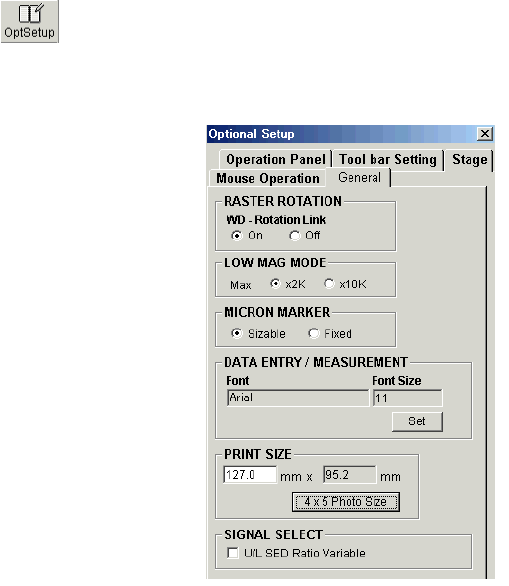
3-103
3.9.15 Optional setting
Operation environments are set on the Optional Setup dialog window.
To open the Optional Setup dialog window, select the Optional Setup command from the
Option menu or click the Opt Setup button
on the tool button area of the operation panel.
.The dialog window has 5 tabs. Each has functions as follows.
(1) General tab : general setting
(a) RASTER ROTATION area
WD-Rotation selection specifies if the image rotation
caused by the objective lens magnetic field is
compensated automatically or not. For normal
operation, it is strongly recommended to enable the
automatic compensation function.
(b) LOW MAG MODE area
Select the highest magnification in the Low Mag
Mode. Use [x2k] for usual operation. [x10k] is only
for special requirements. Image distortion caused by
field magnetic disturbance may appear at
magnification higher than x2k.
(c) MICRON MARKER area
When Sizable is selected, the length of the micron
marker will be adjusted so as the length indication do not have fraction.
If Fixed is selected, the length is fixed to 30mm on 4x5 inches photograph. In this case,
the length value indication some times has fraction, especially by coarse focusing.
(d) DATA ENTRY / MEASUREMENT area
Select font and size to be used in Data Entry and CD Measurement.
(e) PRINT SIZE
Set the size of images when placed on a page using Windows application software. The
setting is effective only on application programs those support the X and Y-Resolution
tags of Tiff files or equivalent header of DIB files. The Aldus Page Maker supports TIFF
files and MS Word also DIB files.
4x5 Photo Size button sets the value just same as photograph size.
(f) SIGNAL SELECT
When the U/L SED Ratio Variable box is checked, in Mix mode the gain ratio of upper
and lower SE detector is kept to which upper and lower detectors are used
independently. It is effective to control ratio of signals detected by both detectors.
If it is not checked, ratio of both two detectors is even. In this case upper detector signal
will be dominant at short working distance and lower detector signal at long working
distance. The latter may be easier to usual operation.


















